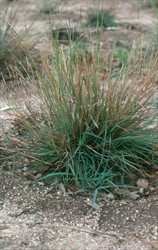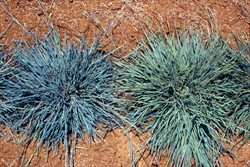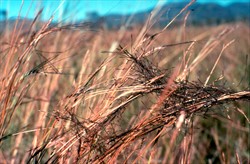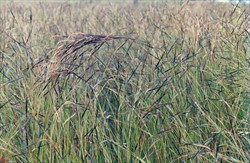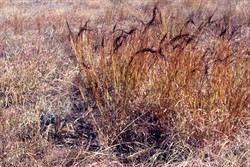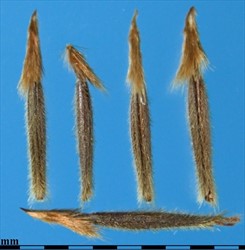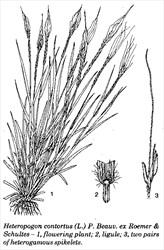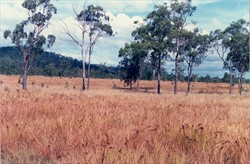Heteropogon contortus
Tropical Forages
Heteropogon contortus (L.) P. Beauv. ex Roem. & Schult.
Basionym: Andropogon contortus L.; Heteropogon hirtus Pers.
Family: Poaceae (alt. Gramineae) subfamily: Panicoideae tribe: Andropogoneae subtribe: Anthristiriinae.
Tufted perennial, variable in form, foliage colour and habit, with foliage depth from 0.2 to 1.2 m, and fertile tillers from 0.5 to 1.5 m tall. Stems often branched above, particularly at flowering. Leaves and sheaths green to grey-green, usuallyglabrous or with a few scattered hairs; leaf blades folded in bud, linear, flat when mature, 3–30 cm long, 2–8 mm wide, abruptly narrowed at the tip, ligule membranous, c. 1 mm long; basal sheaths laterally compressed. Racemes 3–10 cm long (excluding awns), arising singly or in pairs from the axils of the upper leaves; comprising two rows of spikelets; spikelets with outer pedicellate floret enclosing an inner sessile floret; lowermost spikelets at the base of the raceme homagamous, reduced, male or sterile, unawned; uppermost spikelets with sessile floret awned, hermaphrodite, 5–8 mm long, stigmas purple, glumes equal to the spikelet, lower 5-nerved, upper 3-nerved, lower lemma c. 50% the length of the spikelet, sterile, without a palea; upper stipe-like at the base and passing into a twisted awn, the pedicellate floret unawned, 6–13 mm long, male or sterile, the glumes sometimes hairy and enclosing reduced lemmas; the base of the spikelet with a pronounced callus, strongly rufously bearded upwards, forming a sharp point with oblique disarticulation at maturity, the beard acting as barbs; awns brown to black, pubescent, 5–12 cm long, initially symmetrically entwined at the apex of the raceme, becoming hygroscopically active and tangled on maturity (the twisting action of the awn forces the seed into moist ground). Caryopsis cylindrical, 3.5–4.5 mm long, grooved, whitish, 60,000 caryopses/kg; seeds with awns 140,000/kg, de-awned 510,000 seeds/kg.
Africa, East: seericha (Ethiopia); bur-guduud, eebatiitii, ayax-makare, caws guduud (Somali); asilili; ngonga kinyaturu, ng'onga kinyaturu, mahwa kinyaturu (Tanzania); kichoma mguu, kichoma nguo, kishona nguo, kishona (Swahili)
Africa South: assegaaigras, gewone pylgras, gemeines speergras, malgras, pieringgras, pylgras, steekgras, swartangel (Afrikaans); isitupe (Zulu), makurwane (Tswana), selokana, seloka (Sotho); inzala (Zimbabwe)
Africa, West: ahira (Benin); bubongnona sando, celbi, komango, selbo (Burkina Faso); ananugai, chiga (Ghana); fila ntaso, fulanu ntaso, guenemé, moloko, niaderé (Mali); bat-cirey, bat sirey, bata-kirey, mano-selseldé, séoko, uraba, zongwa (Niger); bara babba tudu, bunsurun daji, buzun kura, eru bere, eru buru, jan gargan, kambarahi, silka, sin, tsigà, tsigàà, tsiikaà, yartudu (Nigeria); fila ntaso (Senegal); eru bere (Yoruba)
Asia: 黃茅 huang mao (Mandarin), di jin, ti chin, tic chen, tien chen, tu chin (China); bejeng-bejend, benjeng-benjeng, marakan, merakan (Indonesia); aka-hige-gaya (Japan); sibat-sibatan (Philippines); lem, ya laem, yaa luuk nong, ya nuat ruesi, yaa phung chuu, ya rang tak kataen, yaa rang takka taen (Thailand)
English: assegai fix, assegai grass, bellary grass, black spear grass, bunch spear grass, common spear grass, kusal grass, piercing grass, spear grass, spider’s arrows, stick grass, tangle grass, tanglehead, twisted beardgrass, wild oats
Europe: herbe à moutons (New Caledonia); herbe barbue, herbe polisson (French); Speergras (German)
Indian subcontinent: ahira (Bengali); ucippul (Tamil); aeddi, bandapuncha, barweza, butoo jara, dabhjuliyum, dauria, eddi gaddi, ganjali hullu, gantegawta, gundha goorana, hukara gadi, hurwal, kaarda hullu, kala lapa, kantegawta, kari vunugada hullu, kari-unugada hullu, kaseri gaddi, khar, kher, kumeria, kuneria, kunura, kurunsi pullu, kusal, kusali, kusli, lamb, lambagha, lamb ghas, lamp, lampa, lap, musel, nani sukhali, nanju hullu, oobina hullu, oosi pul, oosi pullu, pandi bella gaddi, pani pullu, panree pullu, paraura, parba, parbi, pareba, parva, parwa, parwaya, pochati, ponia jara, riskawa, saga, saga jara, sarala, sariala, sarari, sarmal, sarol, sarwala, sarwar, sauri ghas, shora, shurighas, shurval, shurwal, sinkola, siyan, sona jara, sookal, sukhli kursali, sukli, sunkhali, sunkari hullu, sura, surari, suriala, survalu, surwal, surwar, surwara, suryala, tambat, yeddi, yeddi gaddi (India); itana (Sri Lanka)
Latin America: flechinha (Brazil); barba negra, hierba negra de los prados, hierba torcida, pasto enredo, rabo de asno, retorcido moreno, saeta, zacate acestilla, zacate colorado, zacate barba negra, zacate retorcido moreno, zacate retorcido; aceitilla, barba negra, cabeza enmarañada, guixi biia, quixi pija, retorcido Moreno, tola, zacate aceitillo, zacate colorado (Mexico); yerba torcida (Puerto Rico)
Madagascar: boka, boka ahidambo
Pacific: lule, pili, pili grass (Hawaii)
Native:
Africa, North: Algeria; Cape Verde; Chad; Eritrea; Ethiopia; Libya; Morocco; Somalia; Sudan; Tunisia
Africa, East: Kenya; Rwanda; Tanzania; Uganda
Africa, West-Central: Benin; Cameroon; Central African Republic; Democratic Republic of the Congo; Gabon; Ghana; Guinea; Liberia; Mali; Mauritania; Niger; Nigeria; Senegal, Sierra Leone; Togo
Africa, South: Angola; Mozambique; South Africa; Zambia; Zimbabwe
Asia, Temperate: China (Fujian, Gansu, Guangdong, Guangxi, Guizhou, Hainan, Henan, Hubei, Hunan, Jiangxi, Shaanxi, Sichuan, Xizang, Yunnan, Zhejiang); Lebanon; Syria; Taiwan
Asia, Tropical: India, Myanmar, Sri Lanka
Australasia: Australia (New South Wales, Northern Territory, Queensland, Western Australia)
Europe: Albania, Croatia, France, Italy, Montenegro, Spain
Naturalized
Northern America: USA (Arizona, California, Florida, New Mexico, Texas); Mexico (Aguascalientes, Baja California, Chiapas, Chihuahua, Coahuila, Colima, Durango, Federal District, Guanajuato, Guerrero, Jalisco, Mexico, Michoacán, Morelos, Nayarit, Nuevo León, Oaxaca, Puebla, Querétaro, San Luis Potosí, Sonora,Tabasco, Tamaulipas, Veracruz, Yucatán)
Caribbean: West Indies
Central America: Belize, El Salvador, Guatemala, Honduras, Nicaragua
South America: Argentina, Bolivia
Pacific: Hawaii
Forage
Native and naturalized stands are used as a warm season fodder grass or pasture. It can be conserved as hay or silage as long as it is harvested before flowering.
Environment
Used for erosion control on up to 20° slopes.
Other
Has some value in providing fawning cover for deer and nesting cover for ground-dwelling birds. It has also been used in Hawaii to thatch huts. Seeds and roots are used in Asian folk medicine.
Soil requirements
Grows on a wide variety of well-drained soils, with surface textures ranging from loamy sand to clay loam, and uniform or texture contrast soils, as well as on very fertile clay loams. It is less common on heavy clay soils. While well-adapted to low fertility, it is not tolerant of extremely low fertility, nor poor drainage or high levels of salinity.
Moisture
It is most abundant where the average annual rainfall is 600–1,000 mm, and where there are marked wet and dry seasons, but is also found in areas well outside these limits, such as an area on the big island of Hawaii receiving 211 mm/yr, and in an area in eastern Argentina receiving over 1,500 mm/yr. It does not tolerate long periods of flooding, but can tolerate a few days’ inundation on otherwise well-drained soils. It does not tolerate waterlogging.
Temperature
Most of the native and natural distribution lies between 30º N and S although some populations are found to 35º N and S. It occurs over a wide 24-hour average annual temperature (AAT24) range from near sea level in Sri Lanka (AAT24 27.9 ºC, SD 1.26) to 3,800 m asl at Puquio in Peru (13°34' S, AAT24 10.9 ºC, SD 1.02) and 1,300 m asl in southern South Africa at 31°52' S (AAT24 15.4 ºC, SD 4.77). Plants are largely dormant during the cooler and/or drier months, and vegetative growth resumes when both temperature and soil moisture levels are adequate. H. contortus is moderately frost tolerant, although plants are usually mature by the time of the first frosts.
Light
H. contortus can tolerate light shade, often dominating the understorey of Eucalyptus woodlands in tropical and subtropical Australia, but is much less shade tolerant than Megathyrsus maximus.
Reproductive development
Largely reproduces through aposporous apomixis but sexual reproduction has also been known to occur in about 15 per cent of cases. Tropical populations are almost exclusively late flowering, while subtropical populations comprise early to late flowering types. Flowering can be delayed by poor soil moisture, even though day length is suitable.
Defoliation
H. contortus is moderately tolerant of grazing, but under constant heavy grazing is dominated by more grazing tolerant or grazing avoiding species such as Digitaria didactyla and Aristida spp., respectively. Proportion of H. contortus in the pasture can be increased by a strategy of deferring grazing for 4 or 6 months or significantly reducing the stocking rate after burning in spring. Where a pasture has already been invaded by undesirable Aristida spp., burning can result in an absolute reduction in the Aristida component independently of grazing treatment. This does not apply with stoloniferous, sward-forming species such as Digitaria didactyla or Cynodon dactylon. Any strategy that includes an increase in seedling numbers presupposes appropriate conditions for seedling emergence and establishment. Stocking levels should be set to favour the H. contortus component rather than grazing-tolerant companion legumes.
Fire
Fire is a useful tool in management of H. contortus stands, and can be used to restore pasture composition, especially if an area is burnt two years in row. It is important that this is supported by the use of low stocking rates to maintain the proportion of H. contortus so the pasture can be burnt when needed. Germination is not directly promoted by the passage of a normal grass fire, but the fire does create a more open situation for seedlings to establish.
Establishment
H. contortus can be planted from seeds or vegetatively. Since commercial seed production presents difficulties, most small-scale establishment has been carried out using vegetative splits. However, when seed is used, it is important to recognise the existence of two dormancy processes, one affecting the naked caryopsis for the first 4 months after harvest (analogous to epicotyl dormancy), the other delaying germination due to the protective influence of structures around the caryopsis up to about 12 months. In its natural state, the twisting action of the hygroscopically active awns and the sharp, barbed tip to the seed play an important role in pushing the seed into the soil surface. As with all relatively small-seeded grasses, seed should be sown no deeper than about 1 cm, preferably into a fine, firm, clean seedbed, and rolled after sowing. The optimal temperature for germination lies between 30 and 35 °C, but is inhibited with night temperatures of 15‒20 ºC). Seedlings do not compete well against co-establishing nitrophilous species such as Chloris gayana and Cenchrus ciliaris in recently cultivated soils where levels of available nitrogen may be high.
Fertilizer
Although H. contortus is adapted to low fertility soils, it is also found on more fertile soils, and responds to moderate applications of nitrogen fertilizer. High levels of fertilizer nitrogen can kill plants. If sown with a legume, applications of fertilizer, particularly phosphorus, can benefit the legume component, and reflect in improved animal performance on the pasture.
Compatibility (with other species)
Not generally compatible with other sown grasses, although is found in association with similar tussock species such as Bothriochloa bladhii and Themeda triandra. Stoloniferous species such as Bothriochloa insculpta or B. pertusa tend to dominate H. contortus under moderate to heavy grazing pressures. Lower fertility legumes such as those listed below can combine well with H. contortus, giving a substantial improvement in animal production from the overall pasture.
Companion species
Grasses: Not normally sown. Occurs naturally with Themeda triandra, Bothriochloa bladhii, and Hyparrhenia spp.
Legumes: Aeschynomene falcata, Chamaecrista pilosa, C. rotundifolia, Listia bainesii, Macroptilium atropurpureum, Stylosanthes guianensis var. intermedia, S. hamata, S. humilis, S. scabra
Pests and diseases
Smut diseases caused by Sorosporium antheseriae, S. caledonicum, Sphacelotheca monilifera and Urocystis skirgielloi affect seed production and often tillering behaviour of tussocks. Seed production is also reduced by ergot (Claviceps pusilla, C. sorghi), particularly under cool, moist conditions. Leaf rust caused by Puccinia versicolor or Uromyces clignyi is common on more mature leaves of H. contortus in various countries. The downy mildew fungus, Sclerophthora cryophila, has been isolated from leaf spot, and the smut fungus, Urocystis skirgielloi, from interveinal leaf lesions, both in India. H. contortus acts as a collateral host for a downy mildew caused by Peronosclerospora sorghi (P. heteropogoni) which also infects Zea mays, and has proven susceptible to maize streak virus in laboratory tests.
Ability to spread
Rarely cultivated, but spreads naturally into disturbed areas of lower fertility in the semi-arid and subhumid tropics and subtropics, assisted by the use of seasonal fires.
Weed potential
It has become a weed in the tropics and subtropics of the American continent and in east Asia. There are attempts to restore native populations in Hawaii.
Nutritive value
Crude protein levels, even in the very young grass, rarely rise above 10%, falling to 4–6% for much of the growing season, and to 2–3% over winter or dry season. Protein digestibility is also low. These are generally lower levels than are found in species such as Megathyrsus maximus and Chloris gayana; e.g. CP in a young, fully expanded leaf of H. contortus has been measured at 9%, compared with 16% for M. maximus in the same situation. Unlike in these species, CP content is not raised greatly by application of fertilizer nitrogen. Phosphorus levels in the dry matter of H. contortus range from 0.09 to 0.15%, and calcium from 0.23 to 0.30%. It also has low sodium levels. Intake and digestibility decline rapidly with age of material and stage of growth; e.g. in plants at early bloom (34% DM, 6.6% CP), ADF was 22% and NDF 52%, compared with mature plants (42% DM, 4.4% CP), at 32% and 64%. respectively.
Palatability/acceptability
Palatable in the early vegetative stages, but becoming less attractive as it matures. By the end of the growing season when there is a preponderance of stem, it is only eaten if supplemented with urea and molasses.
Toxicity
No toxicity problems published. The main problem arises by virtue of the sharp, barbed seeds that contaminate wool and can penetrate skin causing infections.
Dry matter
Growth is strongly influenced by soil characteristics, rainfall and management. Reported annual dry matter yields range from about 0.5 to 8.7 t/ha.
Animal production
Production capability of H. contortus pastures is related to quantity and quality of the pasture. The largely low quality of the pasture can be improved by incorporation of a legume. While this practice leads to improved production per animal, it should not be seen as an opportunity to increase stock numbers. In subtropical Australia, grass alone at modest stocking rates (3–5 ha/A.E.) can support an annual liveweight gain/head of 110‒180 kg, and augmented with legume, 140–200 kg. Degraded pastures are less productive on both per head and per hectare basis
2n = 39, 40, 50, 60, 69, 70, 80, 90. Tropical genotypes are predominantly tetraploid and almost exclusively late flowering, while subtropical genotypes range from tetraploid to nonaploid encompassing early to late flowering types. Although largely apomictic, the appreciable level of sexual reproduction provides opportunity for plant breeding. No breeding programs have been deemed necessary to date.
In the southern hemisphere, flowering occurs from late January and seed is released between March and August. It can probably be treated as a conventional grass seed crop, with a “cleaning cut” at 10 cm stubble height prior to an application of up to 100 kg/ha of fertilizer nitrogen. Hand-harvesting is uncomfortable and should be approached with caution. Machine harvest, either with a combine or brush harvester, presents difficulties due to “balling” of seed-heads with the former, and tangling in the brushes with the latter. Awns must be removed to facilitate later sowing. Seed yields are significantly reduced by leaf and seed-head diseases. There can also be large differences between provenances of the species. H. contortus can produce up to 5,000 seeds with caryopses/m², or roughly 100 kg/ha, although many crops will be lighter than this.
Herbicides such as triclopyr-picloram mixtures and tebuthiuron are used for woody weed and broadleaf weed control in H. contortus grasslands. Like most grasses, it is tolerant of 2, 4-D, but susceptible to glyphosate.
- Adapted to low fertility soils.
- Palatable when young.
- Tolerant of fire.
- Intolerant of waterlogging.
- Intolerant of continuous heavy grazing.
- Difficult to harvest seed.
- Quality declines rapidly with maturity.
- Sed reduces wool quality and penetrates skin.
Bhatt, R.K., Tiwari, H.S., Vandana and Misra, L.P. (2006) Photosynthesis and shade tolerance in tropical range grasses and legumes. Indian Journal of Plant Physiology 11:172–177. krishi.icar.gov.in/jspui/handle/123456789/20920
Cooksley, D.G., Butler, K.L., Prinsen, J.H. and Paton C.J. (1988) Influence of soil type on Heteropogon contortus-Bothriochloa bladhii dominant native pasture in south-eastern Queensland. Australian Journal of Experimental Agriculture 28:587–591. doi.org/10.1071/EA9880587
Gibbs Russell, G.E., Watson, L., Koekemoer, M., Smook, L., Barker, N.P., Anderson, H.M. and Dallwitz, M.J. (1990) Grasses of Southern Africa: An identification manual. Memoirs of the Botanical Survey of South Africa No. 58. Botanical Research Institute, Pretoria, South Africa.
Grice, A.C. and Mcintyre, S. (1995) Speargrass (Heteropogon contortus) in Australia: Dynamics of species and community. The Rangeland Journal 17:3–25. doi.org/10.1071/RJ9950003
Mannetje, L.’t and Shaw, N.H. (1972) Nitrogen fertilizer responses of a Heteropogon contortus and a Paspalum plicatulum pasture in relation to rainfall in central coastal Queensland. Australian Journal of Experimental Agriculture and Animal Husbandry 12:28–35. doi.org/10.1071/EA9720028
Opperman, D.P.J. and Roberts, B.R. (1978) The phenological development of Themeda triandra, Elyonurus argenteus and Heteropogon contortus under field conditions in the central Orange Free State. African Journal of Range & Forage Science 13:135–140. ajol.info/index.php/ajrfs/article/view/780
Orr, D.M. (2004) Dynamics of plant populations in Heteropogon contortus (black speargrass) pastures on a granite landscape in southern Queensland. 4. The effects of burning on H.contortus and Aristida spp. populations. Tropical Grasslands 38:77–87. bit.ly/39uIVpv
Orr, D.M. and Paton, C.J. (1997) Using fire to manage species composition in Heteropogon contortus (black speargrass) pastures. 2. Enhancing the effects of fire with grazing management. Australian Journal of Agricultural Research 48:803–810. doi.org/10.1071/A96131
Orr, D.M., Paton, C.J. and Playford, C. (2004) Dynamics of plant populations in Heteropogon contortus (black speargrass) pastures on a granite landscape in southern Queensland. 2. Seed production and soil seed banks of H. contortus. Tropical Grasslands 38:31–41. bit.ly/2wywRXb
Orr, D.M., Paton, C.J. and Reid, D.J. (2004) Dynamics of plant populations in Heteropogon contortus (black speargrass) pastures on a granite landscape in southern Queensland. 1. Dynamics of H. contortus populations. Tropical Grasslands 38:17–30. bit.ly/33U0Bdl
Orr, D.M., Burrows, W.H., Hendricksen, R.E., Clem, R.L., Rutherford, M.T., Conway, M.J., Myles, D.J., Back, P.V. and Paton, C.J. (2001) Pasture yield and composition changes in a Central Queensland black speargrass (Heteropogon contortus) pasture in relation to grazing management options. Australian Journal of Experimental Agriculture 41:477–485. doi.org/10.1071/EA00132
Orr, D.M., McKeon, G.M. and Day, K.A. (1991) Burning and exclosure can rehabilitate degraded black speargrass (Heteropogon contortus) pastures. Tropical Grasslands 25:333–336. bit.ly/2xsL48b
Orr, D.M., Paton, C.J. and Lisle, A.T. (1997) Using fire to manage species composition in Heteropogon contortus (black speargrass) pastures. 1. Burning regimes. Australian Journal of Agricultural Research 48:795–802. doi.org/10.1071/A96130
Playne, M.J. (1972) A comparison of the nutritional value of spear grass (Heteropogon contortus)-dominant pastures and Urochloa grass (Urochloa mosambicensis). Australian Journal of Experimental Agriculture and Animal Husbandry 12:378–384. doi.org/10.1071/EA9720378
Tothill, J.C. (1966) Phenological variation in Heteropogon contortus and its relation to climate. Australian Journal of Botany 14:35–47. doi.org/10.1071/BT9660035
Tothill, J.C. (1968) Variation and apomixis in Heteropogon contortus, Gramineae. Boletín de la Sociedad Argentina de Botánica 12:188–201. bit.ly/2UrDfZ6
Tothill, J.C. and Hacker, J.B. (1976) Polyploidy, flowering phenology and climatic adaptation in Heteropogon contortus (Gramineae). Australian Journal of Ecology 1(4):213–222. doi.org/10.1111/j.1442-9993.1976.tb01110.x
Tothill, J.C. (1977) Seed germination studies with Heteropogon contortus. Australian Journal of Ecology 2(4):477–484. doi.org/10.1111/j.1442-9993.1977.tb01163.x
Tothill, J.C. (1992). Heteropogon contortus (L.) P. Beauv. ex Roemer & Schultes. In: Mannetje, L.’t and Jones, R.M. (eds) Plant Resources of South-East Asia No. 4. Forages. Pudoc Scientific Publishers, Wageningen, the Netherlands. p. 106–108. edepot.wur.nl/327785
van Oudtshoorn, F. (1999) Guide to Grasses of Southern Africa. Briza Publications, Pretoria, South Africa.
None released.
None reported.
